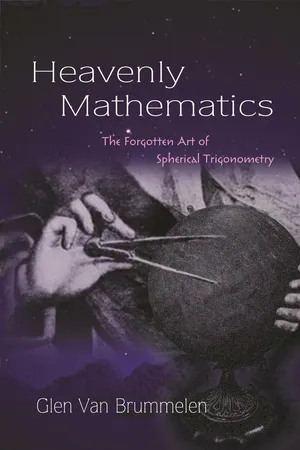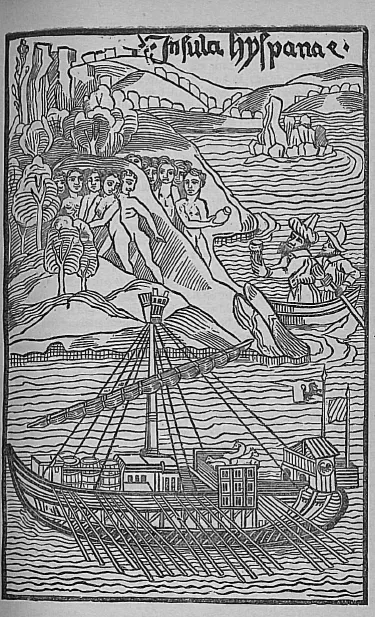![]()
Heavenly Mathematics
We’re not ancient anymore. The birth and development of modern science have brought us to a point where we know much more about how the universe works. Not only do we know more; we also have reasons to believe what we know. We no longer take statements on faith. Experiments and logical arguments support us in our inferences and prevent us from straying into falsehood.
But how true is this, really? Do we really know, for instance, why the trajectory of a projectile is a parabola? In fact, anyone who has seen a soccer goalkeeper kick a ball downfield is aware that the ball’s path is anything but symmetric. And yet, students accept their physics teachers’ pronouncements about parabolas at face value—on authority. We trust our teachers to tell us the truth, just as we imagine medieval churchgoers accepting with blind faith the word of their priests. If we thought about it a little, we might recognize that air resistance is the culprit in the ball’s divergence from a parabolic path. But do we know even this? Has anyone ever seen a soccer ball kicked in a vacuum?
It’s impossible to live in our society (or any other) without taking some body of knowledge on authority. No one has the energy, or capacity, to check everything. We accept that the earth is a sphere (well, most of us anyway), without really knowing why. Only in one discipline—mathematics—is the “why” question asked at every stage, with the expectation of a clear and indisputable answer. Now, this is not the case in a lot of mathematics training in high school these days. Very few textbooks ask why sin(α + β) = sinαcosβ + cosαsinβ. But this is the fault of modern textbooks and pedagogy, not of the subject itself. There is an explanation for this equation, and we’ll see it in this chapter.
The goal of this chapter is twofold. Firstly, we will revisit topics in plane trigonometry in order to prepare for our passage to the sphere. But our second purpose takes precedence: to explore and learn without taking anything on faith that we cannot ascertain with our own eyes and minds. This is how mathematics works, and by necessity it was how ancient scientists worked. They had no one to build on. Our mission is as follows:
Accepting nothing but the evidence of our senses and simple measurements we can take ourselves, determine the distance to the Moon.
Turning our eyes upward on a cloudless night, within a few hours we come to realize a couple of simple facts. The sky is a dome, perhaps the top half of a sphere, and we are at its center. (Don’t forget, in this exercise we are not to accept the word of dissenting teachers and scientists!) The points of light on this hemisphere revolve in perfect circles around Polaris, the North Star, at a rate of one complete revolution per day (see plate 1).* By the disappearance of constellations below the horizon and their reappearance hours later, we may infer that the sky is an entire sphere (the celestial sphere), of which we can see only half at any one time.
But this observation does not narrow the possibilities regarding the shape of the Earth. Any planet that is sufficiently large with respect to its inhabitants will appear to be flat from their vantage point, discounting minor irregularities such as mountains and canyons. The most natural hypothesis is that the Earth is a flat surface (figure 1.1); it is also possible (although harder to imagine at first) that the Earth is a sphere or some other solid. How are we to choose?
Many of us have heard in school stories of those who believed in the flat Earth, perhaps even seen images from past sailors’ nightmares: a ship sailing off an infinite waterfall at the edge of the Earth’s disc. These often accompany tales of Christopher Columbus heroically attempting to convince the conservative Spanish court that the Earth is a sphere rather than a disc, making it possible to sail westward from Portugal to India. When I was a child, my teacher told me how a young Columbus, coincidentally about my age, discovered the curvature of the Earth. While watching a ship sail away from shore, Columbus noticed that its hull would be the first part to disappear, and eventually just before it vanished altogether, the only part left visible was the top of its mast (figure 1.2).
Figure 1.1. Engraving from Camille Flammarion’s L’Atmosphère Météorologie Populaire, 1888. Source: http://en.wikipedia.org/wiki/File:Flammarion.webp.
Figure 1.2. Columbus’s line of sight as a ship sails away.
All of this is fiction. Columbus was trying to convince the Spanish court of the Earth’s size, not its shape. In fact, Columbus thought the Earth was smaller than it actually is, and he fortuitously came upon the West Indies approximately where he thought the East Indies were supposed to be. His error was caused, in part, by his use of an Arabic estimate for the length of a degree of latitude, which he assumed was in Roman miles, but in fact was in Arabic miles. Moral of this story: watch your units. The story of the ship disappearing below the horizon that my teacher attributed to Columbus is actually 1500 years older, in the Greek scientist Strabo’s writings around the time of the birth of Christ. Centuries before that, Aristotle had given several arguments for the sphericity of the Earth, including the observation that the shadow cast by the Earth on the Moon during a lunar eclipse is always a circle.
I should have known that my teacher was telling a story. Who else but sailors would be the first to notice how ships disappear below the horizon? Ever since Aristotle, hardly any observant people, whether navigators, theologians, or scholars, have considered the Earth to be flat. The modern myth of ancient belief in the flat Earth was popularized by the 19th-century novelist Washington Irving in an imaginative biography of Columbus (figure 1.3). Historians of science have been trying (mostly unsuccessfully) to curb its spread ever since. So we shall accept what we now know are ancient ideas that the Earth is round, and turn our exploration of the universe away from shape and toward size.
Figure 1.3. Columbus arrives at the New World, in Washington Irvin...





